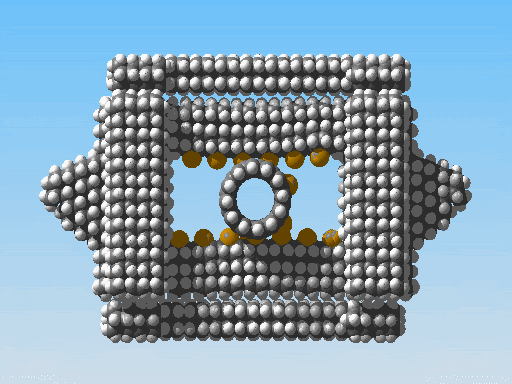
I stayed up to see how the new design worked. I appear to be getting closer. This clip is on the short side, didn't see the need for a really long one if the whole thing broke apart right away. I will make some adjustments where the plates ejected a few atoms and raise the torque on the pinion.
More to follow.

3 comments:
On using a nanotube as an axle, I'm not sure whether it is (or is not) a good part for this purpose. An axle needs to resist twisting. Nanotubes have very high tensile strength, but I'm not sure how good they are at resisting a twisting deformation. A couple of simulations might be in order -- attach a "heavy object" to the nanotube at each end and see what happens if you put a strong torque on one of the anchors.
Almost certainly, the longer the nanotube gets, the more you will get a twist in the axle under high torque, though how bad the phenomenon would be I can't say a priori. (This is not to say that nanotubes are bad axles, just that I worry that they might be. They're sexy and popular because we can make them with ridiculously low tech mechanisms, but that does not necessarily mean they make good general parts -- it is worth testing.)
Another issue to consider at this point: the "teeth" are single atoms, and force with which the system can turn will be limited by the bonding strength of those "teeth" to the rest of the structure. You may want to do some back of the envelopes on that, comparing force to bond strength, at the very least.
Lastly, I'd still beware of chemistry happening at the teeth. When you put stress on bonds, they find all sorts of unexpected ways of reducing the stress by rearranging. It might be helpful to run very limited ab initio simulations of the ten or so atoms proximate to the teeth, especially in situations where substantial stress is going to be placed on components in close proximity. Your goal, after all, is a machine type action, and not mechanosynthesis.
BTW, feel free to email me. I'm easily found via google.
Thanks again. Your bring up some interesting points.
I have had doubts about the nanotube pinion as well. My main worry is it will be crushed, or the torque required to move the rack will break it apart or break the bonds holding on the sulfur teeth. I had not thought of twisting.
My main interest in working with nanotubes, beyond being sexy, is I see them, and fullerenes, as nature's molecular erector sets, so I try to use them where ever possible.
I am glad you brought up the force and the bond strength. It has been on my mind too. I know the torque of the pinion,the length of the moment arm, the angle which the gear tooth makes contact, so from this I should be able to calculate the force applied to the sulfur atoms along the X and Y axises. I can probably look up the bond energy of the carbon-sulfur bonds. Then I get a little hazy. I know that if the energy applied exceeds the bond energy, then the bond will break. From the temperature the simulation is ran at, I should be able to get a rough idea of the average kinetic energy of the atoms
(I am not sure if NE1 uses a full statistical mechanics model, so average should work just fine) Treating the atoms as masses attached to springs (NE1 uses only classical mechanics) I should be able to calculate how much potential energy is being added from the gear if I can get an idea of the "spring constant" would be in this case. Then if the kinetic
energy plus the new potential energy exceeds the bond energy, the bond breaks? I have been looking through my copy of Nanosystems this evening, but no answers are jumping out at me. Any thoughts?
Any chemistry happening at the teeth is currently beyond by knowledge base. Any additoinal information you can offer there would be appreciated. But my gut tells me the entire structure should be diamondoid anyway.
Thanks for the email invite. I plant to take up of on it.
I have sent you an email, assuming I got the right guy.
Post a Comment